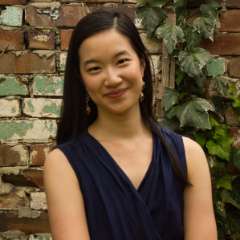“Go digital!” Opera Australia told Chen Shi-Zheng when he was briefed to direct Wagner’s Ring cycle, which premieres in Brisbane this December.
“Digital is hard,” laughs Chen. “You know those LED backdrop panels? You turn them on and they are so bright! Even when you use a normal computer, you only use a small percentage of the brightness. I realised nobody wanted to be facing this huge bright thing for four hours – you’d need to give the audience sunglasses. So we darkened the LED panels and used a lot of negative space. It reminded me of classical Chinese paintings, where ninety percent of the space is vacant and the remaining ten percent is the feature. Like you’d paint just one fish in this huge ocean.”
Colossal expanses of dark space are not only comfortable on the eyes, but also fitting with Chen’s vision for a vast, space-age Ring cycle of epic proportions. “The storming, the cycles of nature, the weather pattern... And not just earthly nature, but the galaxies, the universe. Because this opera reflects how gods, humans – how all creatures – move, how they come to us, and how we go to them.”
To work on this epic vision, Opera Australia engaged the innovative flora&faunavisions digital studio (“FFV”). Based in Berlin and directed by the visionary industry leader Leigh Sachwitz, FFV is renowned for creating multidisciplinary immersive projects such as Genius, the digital installation inspired by the work of Leonardo Da Vinci.
“Digital images,” Sachwitz explains, “give us the opportunity to explore in a way that you can’t really do if you’re working more statically or traditionally. We have the opportunity to build something up. You could start with just a dot and end up in a sandstorm.”
Sachwitz and her team spent years creating the kinetic digital staging for the Ring, incorporating the latest interactive technology into their designs. The beginning of each opera, for instance, features an AI piece where AI responds to Sachwitz’s prompts. “It’s just like programming, you have to tell it what to do. But definitely it’s fun to see these images, to be abstract with the storytelling and create these different layers, which give us the possibilities and leave us the space in our minds to have this imagination, this individual connection to the work. It’s very different to having somebody visually on a stage almost spell it out for you in a traditional way.”
For the Rhinemaiden scenes, FFV engaged motion-tracking so that the performers can interact spontaneously with animations. “They’ll really be able to dance as if they were fish,” enthuses Sachwitz, “because the way that this tracking works is that it synchronizes with their physical movements. They’re tracked using beacons on their costumes, and the motion sensors will pick up their movement. If they lift their hand towards the screen, a swarm of digital fish will appear. It makes everything totally dance together – the music, the singing, the imagery, the lighting. Because it’s all reacting together using technology, it’s not being cued in that kind of traditional way.”
Given the complexities of creating digital content, FFV’s creative process was extremely labour intensive. “Fifteen hours of performance time is already a huge thing,” Sachwitz observes. “And then going in deeper once you know what your images are, once you have your style frames – you need to start looking at rhythm, at movement, at the frame on stage, at the colours. How to build up, how to drop down. What's happening in the music? What are they wearing? What’s the lighting doing? What's movement doing? Just going deeper with every step along the way.”
FFV tackled this gargantuan project by first building a VR stage, where Sachwitz’s team could experiment virtually with the LED panels and the “different constellations of scenography”.
“We’re pretty much done,” Sachwitz grins. “The main issue now is to bring it all together in the tech room and look at it. But in the end, there’s nothing like the live experience. Even if you build it in 3D or in VR like we did, whatever your process is as a designer, it’s just a process. It’s still not what you will feel and see when you have a live orchestra, a physical room, an evening: when you have this epic opportunity. So that’s really what we’re working towards right now, to make sure that this actual moment in time – when the audience sits and watches this production – is totally amazing and completely synchronised and that it ultimately just blows everyone away.”
Sachwitz is earnest about what digital work means for the future of classical music. “Where are we going with opera in the future and how are we going to keep classical music alive for audiences? I do think that we need to embrace technology, and use it as a tool to do great things. And if we manage to do that, then we’ll be able to activate younger audiences.”
“Because classical music is so important,” Sachwitz reflects. “We have a responsibility as designers and as creators… to make sure that we pass on, and grow, and modernise it for the new generation. Otherwise, it will die out, right? And no one will go to theatres anymore.”
“I feel responsible in a way for that,” she concludes. “And I hope that the older audiences are open enough to embrace the newness. The combination of this music, which was written so long ago but is still so relevant, combined with this new way of expressing, through digital art rather than painted sets”.
Opera Australia’s Ring cycle runs at Queensland Performing Arts Centre, Brisbane, from 1st–21st December.
This article was sponsored by Opera Australia.




